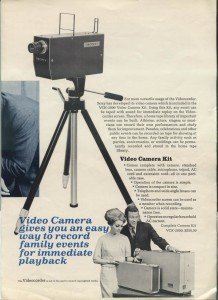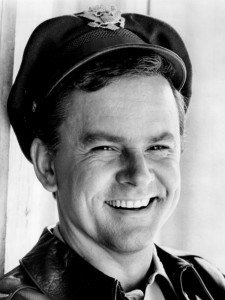Death By Tripod Or:Bob Crane’s Heart Will Go On

The cables are like snakes; big, black things writhing and twisting when either detached from the heavy-metal box or hooked into it’s feminine grasp. The box is the size of a snare drum, but it weighs close to fifty pounds and across the scuffed, stainless steel face plate, you can see the words, ‘SONY VIDEOCORDER”. It operates on the same principle as any VTR, from Beta to Hi-8, with an enormous spinning drum and reading heads, but it utilizes open reel (like professional recording tape) magazines and magnetic tape with no cartridge, and requires threading like film stock.
You could get the tape stock in two sizes, relative to the length of time you could record – V32 or V62, but the images produced were black & white only (actually more of a jarring Electronicam-like monochrome) that jumped and bended on the screen when played. The prototype was developed in 1964 and then quickly mass-produced in 1967.
The camera tells another story. A standard configuration; heavy with a pistol-grip, a removable lens, and a detachable rectangular monitor box for on-the-fly viewing, but the weight and brief connection cables make portability an issue. These video systems were popular among the elite of Hollywood at that time. People like Warren Beatty, Jack Nicholson, Roman Polanski, Dennis Hopper, Burt Reynolds, Clint Eastwood, and Steve McQueen purchased them.

Bob Crane got his first home video camera through a contact by way of “Hogan’s Heroes” co-star (and eventual game show host) Richard Dawson. John Carpenter (not the filmmaker, obviously) worked for Sony and sold equipment to most of the celebrities I mentioned. Carpenter and Hogan struck up a friendship, primarily based on their love of photographing sexual encounters with a plethora of gorgeous starlets. Crane enjoyed the ease with which he could record images as opposed to shooting footage with the motion picture format, and also having to wait for the film to be developed.
Roman Polanski had a penchant for filming his sexual encounters as well. When police searched his home in Benedict Canyon after the Manson murders of his wife and friends, they found several reels of V-32 tape in the loft above the living room. After locating a playback unit and viewing the footage, they sheepishly returned the reels to where they had been found, realizing the tapes contained intimate footage of the director and his wife.
For years, there were stories of wild Hollywood sex orgies being recorded with this camera. It makes the curious mind wonder why (when there were so many practical applications for which this camera could be used) the first users of this camera saw it mainly as a vehicle to document sexual conquest. I know it’s Hollywood, but come on! Instead of using the camera as a teaching tool, or for industrial application, we are witness to the birth of the sex tape.
The “sex tape” is a truly bizarre phenomena. Once considered scandalous, repulsive, and appalling, the sex tape is now a stepping stone to a celebrity’s eventual career. The culture of Reality-“based” television makes a mockery of true talent, pushes stardom as a cheap commodity, and sends the wrong message to future generations: that audacity and aptitude are one in the same.
In his last moments of life, Bob Crane was strangled with a video cable and then bludgeoned with a tripod – a fitting end to a strange, somewhat confused life. A man who loved the ladies, a popular disc jockey, a well-known actor, a jazz drummer, devoted father and loving husband (perhaps too loving), a self-described sex-addict (before it was cool), and a filmmaker way ahead of his time.
I speculate that his last breaths were exhaled while turning over in his bed, slumping to his wall-to-wall carpeted floor and crawling over to his beloved heavy-metal goddess, the Sony Videocorder, flipping the toggle to [rec] and documenting his fading heartbeat, in essence burning it into the magnetic tape. Yes, Bob Crane’s heart rests forever under the spinning drum of a low-resolution dream.
